Caterpillars come in a variety of colors and shades. And a surprisingly large number of caterpillars are black and yellow. So, identifying a yellow and black caterpillar that you came across in the wild or saw munching on some leaves in your backyard is no easy feat. However, if you know what to look for, it is easy, and we are here to help!
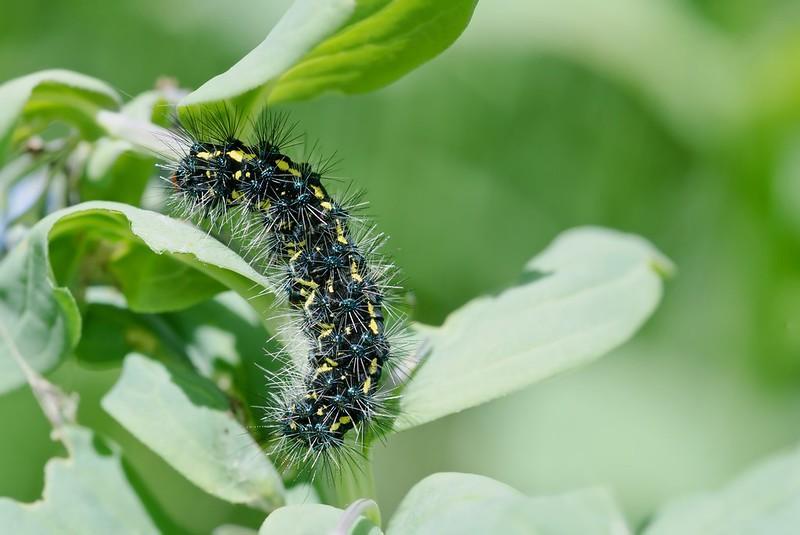
Police car moth caterpillars have black barbs that penetrate the skin, dig in, and deliver stinging toxins.
Yellow and black caterpillars are larvae of butterflies and moths. They can either be small and skinny or large and furry. Furthermore, some black and yellow caterpillars have spines, barbs, and colored spots on their bodies. So, when identifying a caterpillar, you must pay close attention to its size, body features (shape, size, and pattern of spots on the body), and sometimes even its behavior and habitat.
Nevertheless, let’s move on to the list and give you what you came for.
RELATED: What Do Caterpillars Eat? Top 3 Host Plants You Must Know!
Types Of Black And Yellow Caterpillars
1. Red Admiral Butterfly Caterpillar
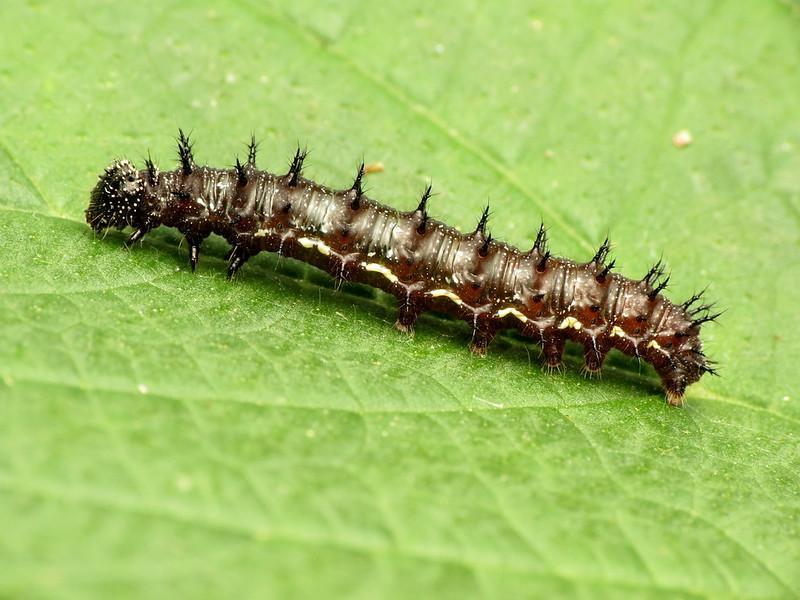
Fun Fact: their primary hosts are stinging nettles, and the spines on their bodies are sensory organs called “setae.”
Quick Facts
| Scientific Name | Vanessa atalanta |
| Other Names | Red Admiral Butterfly caterpillar, Atalanta Butterfly caterpillar |
| Length | 4-5 cm / 1.6-2 inches |
| Width | 1 cm / 0.4 inches |
| Host Plants | Nettles, false nettles, pellitory |
| Distribution | North America, Europe, Asia, Africa |
| Dangerous or Not? | Not dangerous |
| Pest Status & Damage | Considered a pest to some crops, but not a significant threat |
Description & Identification Guide
Variable in color, ranging from yellow and black to full black, the red admiral butterfly caterpillar usually eats bird droppings, tree sap, and rotting fruit. However, they will also much on flowers and drink the nectar if given a chance. Each red admiral butterfly caterpillar makes many shelters (tent-shaped covers made out of leaves) during its lifetime and discards the old ones, which can be used to pinpoint the caterpillar’s location.
2. Neighbor Moth Caterpillar
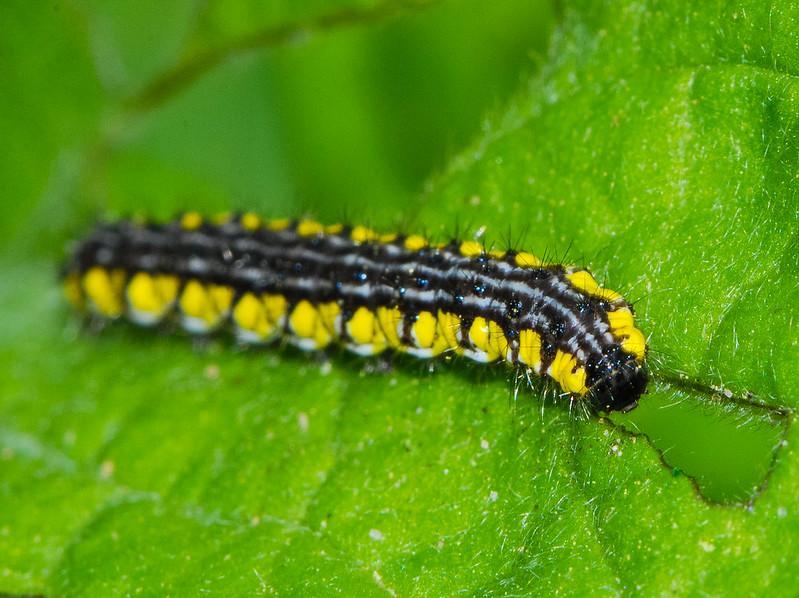
Fun Fact: Neighbor Moth Caterpillars have only one generation per year.
Quick Facts
| Scientific Name | Haploa contigua |
| Other Names | Contiguous Tiger Moth |
| Length (cm/inches) | 3.5-5 cm / 1.4-2 inches |
| Width (cm/inches) | 1.2-2.5 cm / 0.5-1 inch |
| Host Plants | Various plants, including asters, daisies, and goldenrods |
| Distribution | Eastern and central North America |
| Dangerous or Not? | Not dangerous |
| Pest Status & Damage | Generally not considered a pest. |
Description & Identification Guide
Unlike the red admiral butterfly caterpillar with faint yellow spots on its black body, the larva (caterpillar) of the neighbor moth caterpillar has broad and bright yellow stripes along both sides of the body, making spotting them pretty straightforward.
Neighbor moth caterpillars also have tufts of short, sharp bristles like tent caterpillars, but they don’t make tents. After their first feeding frenzy, which ends with the caterpillars overwintering, they remerge, feed on many other plants, and then pupate.
3. Virginia Ctenucha Caterpillar
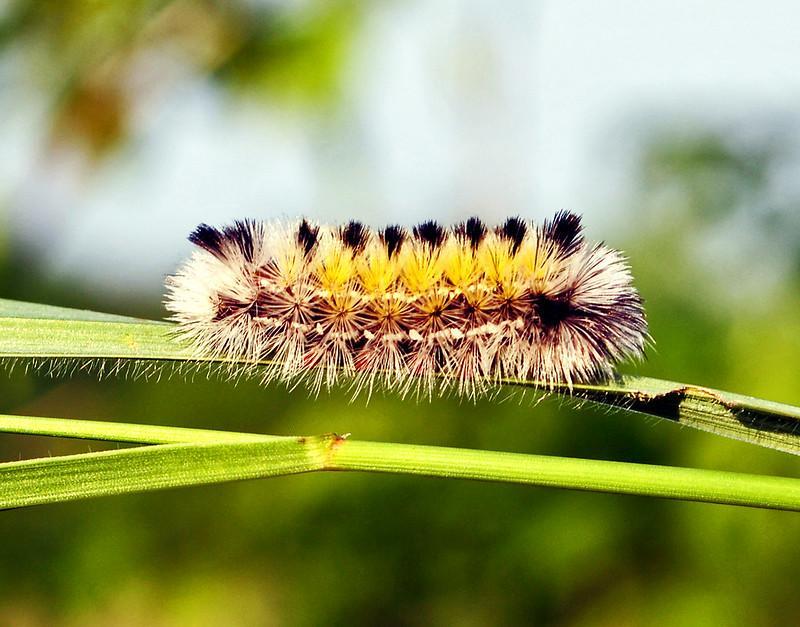
Fun Fact: They pupate in cocoons they make using their hairs, and when disturbed, they curl up in a ball.
Quick Facts
| Scientific Name | Ctenucha virginica |
| Other Names | Virginia Ctenuchid Moth Caterpillar |
| Length | 3.5-5 cm / 1.4-2 inches |
| Width | 1.2-1.5 cm / 0.5-0.6 inches |
| Host Plants | Various types of grass, sedges, and rushes |
| Distribution | Eastern and central United States |
| Dangerous or Not? | Not dangerous |
| Pest Status & Damage | Larvae can feed on grasses and sedges |
Description & Identification Guide
With tufts of spine-like hairs covering the body and bright warning coloration, everything about this caterpillar says, “do not come near me, or I will mess you up.” However, looks can be deceiving, and Virginia Ctenucha Caterpillar is a good example. The caterpillar is not dangerous to humans or other animals and can be handled if seen.
4. Toadflax Moth Caterpillar
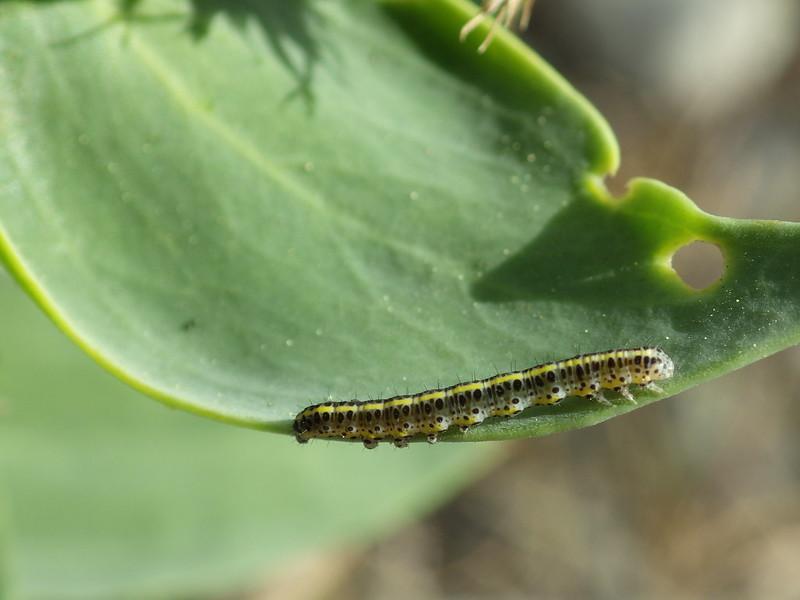
Fun Fact: When threatened, the caterpillar emits a chemical to deter predators.
Quick Facts
| Scientific Name | Calophasia lunula |
| Other Names | Toadflax Brocade, Snapdragon Moth Caterpillar |
| Length | 3-4 cm / 1.2-1.6 inches |
| Width | 0.8-1 cm / 0.3-0.4 inches |
| Host Plants | Toadflax (Linaria spp.) and snapdragons (Antirrhinum spp.) |
| Distribution | Europe and North America |
| Dangerous or Not? | Not dangerous |
| Pest Status & Damage | Larvae may feed on the leaves and flowers of host plants. |
Description & Identification Guide
These caterpillars are easy to identify thanks to their distinctive color and body patterns. The body is purplish. However, purple fades away as the caterpillars mature, and the black and yellow markings on their bodies become more apparent. Toadflax moth caterpillars undergo five molts in one month when growing and feeding. Nevertheless, once the caterpillar reaches the size of 4 cm, it pupates over the winter and emerges as a moth.
5. Buff-Tip Moth Caterpillar
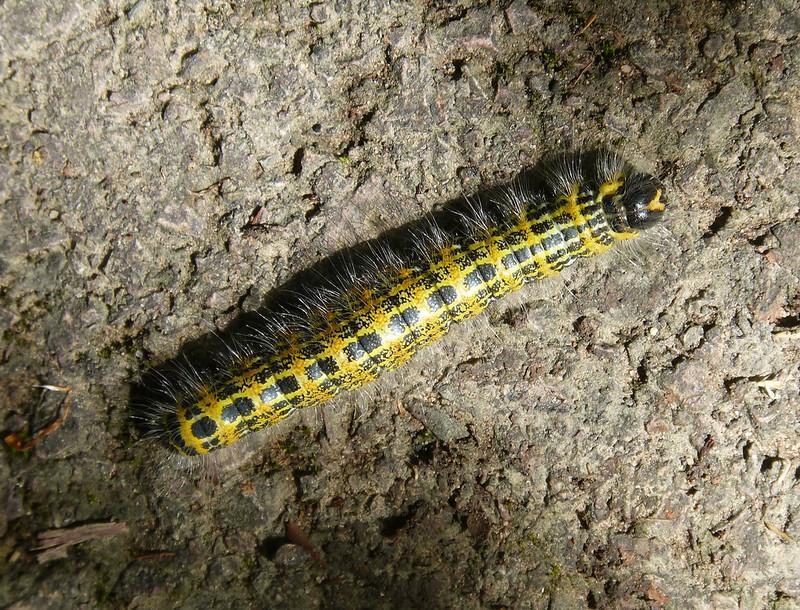
Fun Fact: Buff-Tip Moth confuses predators by making its wings resemble broken twigs.
Quick Facts
| Scientific Name | Phalera bucephala |
| Other Names | Buff-Tip Moth Caterpillar, Buff Ermine Caterpillar, Ochreous Buff Caterpillar |
| Length | Up to 6 cm (2.4 in) |
| Width | Up to 2 cm (0.8 in) |
| Host Plants | Various deciduous trees, including birch, oak, and hazel |
| Distribution | Europe, Asia, North Africa |
| Dangerous or Not? | Not dangerous |
| Pest Status & Damage | Considered a pest due to defoliation of host plants |
Description & Identification Guide
Buff-Tip Moth Caterpillars have a tube-like body and distinct orange, yellow and black spots covering their entire, soft, and delicate bodies. Unlike many other yellow and black caterpillars, Buff-Tip moth caterpillars do not form a nest. However, they do live socially when young.
These caterpillars can be seen from July to early October before they pupae underground. Their large congregations and large hairy and fuzzy bodies make their identification easier and can help detain an outbreak in its early stages.
6. Grass Eggar Moth Caterpillar

Fun Fact: The hairs on the caterpillar can cause skin irritation in humans who handle them.
Quick Facts
| Scientific Name | Lasiocampa trifolii |
| Other Names | Grass Eggar Moth Larva, Trefoil Dart Caterpillar |
| Length | Up to 6 cm (2.4 in) |
| Width | Up to 2 cm (0.8 in) |
| Host Plants | Various types of grass, including common couch grass & sweet vernal grass |
| Distribution | Found throughout Europe and parts of Asia |
| Dangerous or Not? | Not dangerous |
| Pest Status & Damage | They are considered minor pest |
Description & Identification Guide
Grass Eggar Moth Caterpillar is an unusual caterpillar with a rounded head and an extremely fuzzy body. The body is fuzzy or wooly because it is entirely covered with fine yellow hair that might look cute but should not be touched as it can irritate the skin.
The caterpillars pupate in tough brown cocoons on the ground for a long time (about 8 to 10 weeks), and they can be seen from March to July feeding at night.
7. White-Lined Sphinx Moth Caterpillar
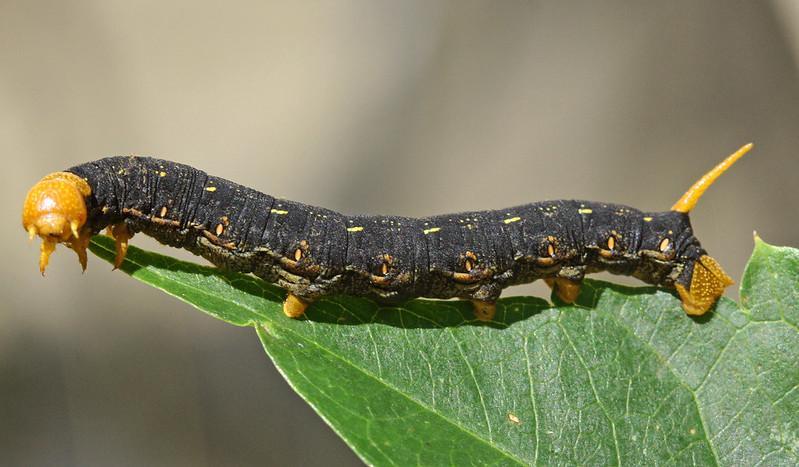
Fun Fact: The caterpillar has a unique defensive behavior: it raises its head while emitting a loud clicking noise.
Quick Facts
| Scientific Name | Hyles lineata |
| Other Names | White-lined Sphinx Caterpillar, Hawk Moth Larva, Hummingbird Moth Larva |
| Length | Up to 8 cm (3.2 in) |
| Width | Up to 1.5 cm (0.6 in) |
| Host Plants | Various plants, including tomato, grape, and primrose |
| Distribution | Found throughout North, Central, and South America |
| Dangerous or Not? | Not dangerous |
| Pest Status & Damage | They can defoliate crops sometimes. |
Description & Identification Guide
The caterpillar of the Sphinx moth is a sizeable slug-like insect with brownish spots and small triangular black markings on its sides. However, this particular caterpillar can be hard to identify as its color varies. However, do not worry; you can still recognize it with its yellow or orange horn with a black tip. However, there is no need to be afraid. It is not a stinger.
RELATED: Black Caterpillar Types: How To Identify Common Species, Fun Facts And More!
8. Magpie Moth Caterpillar
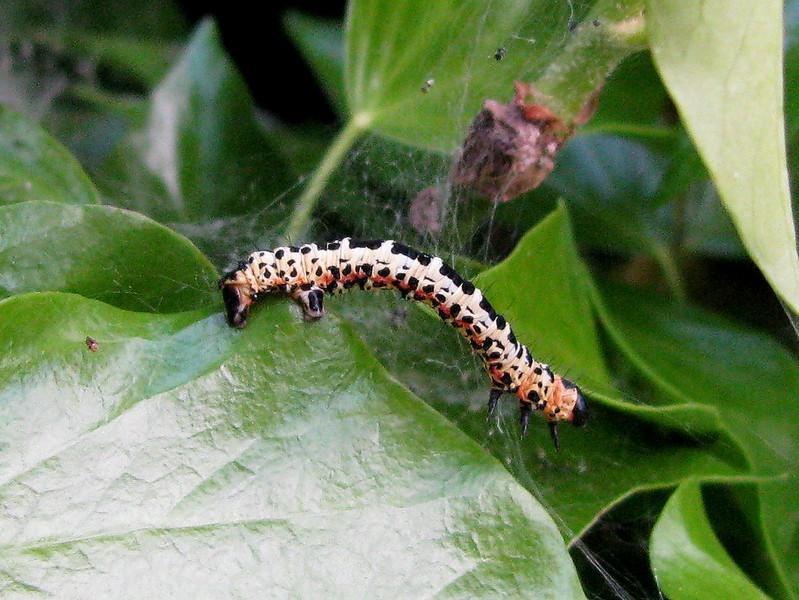
Fun Fact: The caterpillar’s striking striped pattern warns predators that it is poisonous and should not be eaten.
Quick Facts
| Scientific Name | Abraxas grossulariata |
| Other Names | Magpie Moth Larva, Currant Moth Caterpillar |
| Length | Up to 4 cm (1.6 in) |
| Width | Up to 1 cm (0.4 in) |
| Host Plants | Currant and gooseberry bushes |
| Distribution | Found throughout Europe and parts of Asia |
| Dangerous or Not? | Not dangerous |
| Pest Status & Damage | They are considered a pest. |
Description & Identification Guide
Magpie moth can be seen from late August to the following June, overwintering on its food plants. It has an orange stripe at the base of its abdomen and broken black lateral bands along its body. Furthermore, the caterpillar’s body is sparsely covered with delicate black hair. And, if you still have difficulty identifying it, look towards its movement. The caterpillar loops as it moves over the foliage and stems of its host plants.
9. Cabbage White Caterpillar

Fun Fact: The caterpillar can camouflage itself by changing color to match the plant it is on.
Quick Facts
| Scientific Name | Pieris brassicae |
| Other Names | Cabbage White Larva, Large White Caterpillar |
| Length | Up to 5 cm (2 in) |
| Width | Up to 1 cm (0.4 in) |
| Host Plants | Various plants in the mustard family, including cabbage and broccoli |
| Distribution | Found throughout Europe, Asia, and parts of Africa |
| Dangerous or Not? | Not dangerous |
| Pest Status & Damage | They are considered a major pest. |
Description & Identification Guide
These caterpillars’ bodies are filled with features and markings that can be used to identify them. For example, they have a yellow middorsal line, a yellow middorsal line, a black ring around the spiracles, and tiny black pints on an overall bluish-green body.
You can even tell if they are present by looking for holes in the leaves of their host plants. Another interesting fact is that these caterpillars change body color as they mature. First, they are pale yellow, then dark yellow, and when they are about to pupate, they become somewhat greenish.
10. Lily Borer Caterpillar
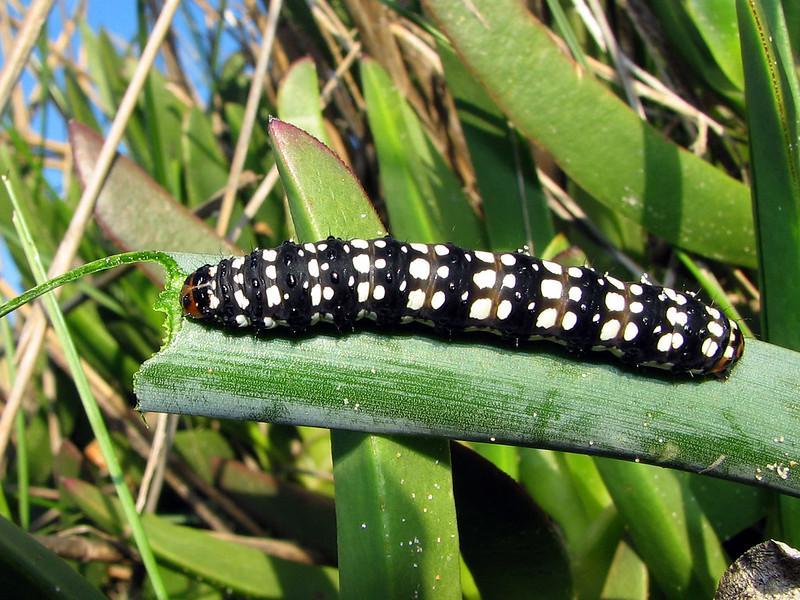
Fun Fact: The Lily Borer camouflages itself by covering its body with bits of the plant it feeds on.
Quick Facts
| Scientific Name | Diaphone eumela |
| Other Names | Lily Moth Larva |
| Length | Up to 5 cm (2 in) |
| Width | About 1 cm (0.4 in) |
| Host Plants | Lilium and Fritillaria species |
| Distribution | Found in Asia and Europe |
| Dangerous or Not? | Not dangerous |
| Pest Status & Damage | Considered a pest due to its ability to damage lilies |
Description & Identification Guide
The caterpillar’s black spots resemble the markings on a leopard’s skin, giving it the nickname “Leopard Lily Borer.” It is a brightly colored yellow and black caterpillar with black and brown bands around each body segment.
Some red dots are also on top of each segment, making identifying Lilly Borer Caterpillar easier. Also, like the white cabbage caterpillar, the lily borer caterpillar leaves tell-tale holes on its host plants.
11. Scarlet Tiger Moth Caterpillar
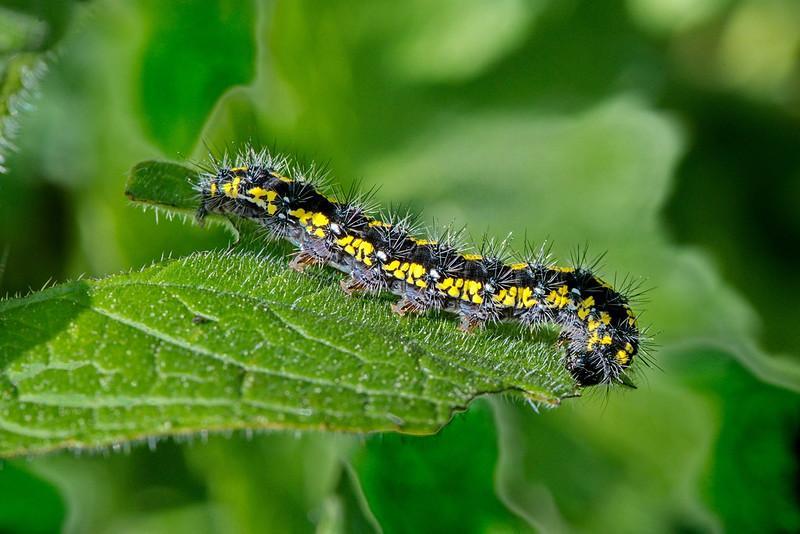
Fun Fact: These caterpillars emit a foul-smelling liquid when they feel threatened, which deters predators.
Quick Facts
| Scientific Name | Callimorpha dominula |
| Other Names | Scarlet Ermine, Spotted Tiger Moth |
| Length | Up to 4 cm (1.5 in) |
| Width | About 1 cm (0.4 in) |
| Host Plants | A variety of herbaceous plants and trees |
| Distribution | Found throughout Europe and Asia |
| Dangerous or Not? | Not dangerous |
| Pest Status & Damage | Considered a pest |
Description & Identification Guide
These yellow and black caterpillars are pretty conspicuous in the daytime from March to May when they feed or rest in the sunlight on their host plants. Their predominantly black body is covered in large yellow and small white spots, which also have turf of short hair arising from them. Scarlet Tiger Moth Caterpillars complete their development in two sessions. They hatch in March, then overwinter and hatch again in March to enter pupation.
12. Amaryllis Borer Caterpillar
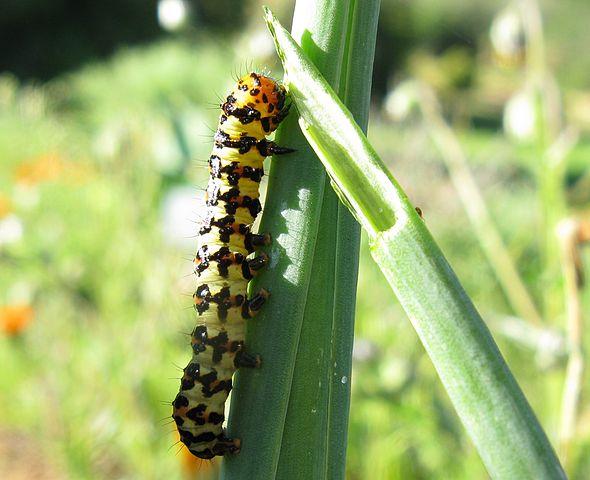
Fun Fact: Its defensive secretion contains compounds that can be used in developing new drugs.
Quick Facts
| Scientific Name | Brithys crini |
| Other Names | Amaryllis Borer, Lily Borer, Hippeastrum Caterpillar |
| Length | Up to 5 cm (2 inches) |
| Width | Up to 0.6 cm (0.25 inches) |
| Host Plants | Amaryllis, Crinum, Hippeastrum, and other bulb plants |
| Distribution | Found in North and South America |
| Dangerous or Not? | It can be considered a pest to garden plants. |
| Pest Status & Damage | The caterpillars cause damage and can potentially kill the plant. |
Description & Identification Guide
Amaryllis Borer Caterpillar has a cigar-shaped black body with pale yellow bands encircling each body segment. And, if you look closely, you can also see tiny black hair arising from its body. Another way you can tell if you are looking at an Amaryllis Borer Caterpillar is to check its head. If it has a pale yellow band, a black body, sparse black hair, and a reddish head, it is an Amaryllis Borer Caterpillar.
13. Alder moth Caterpillar
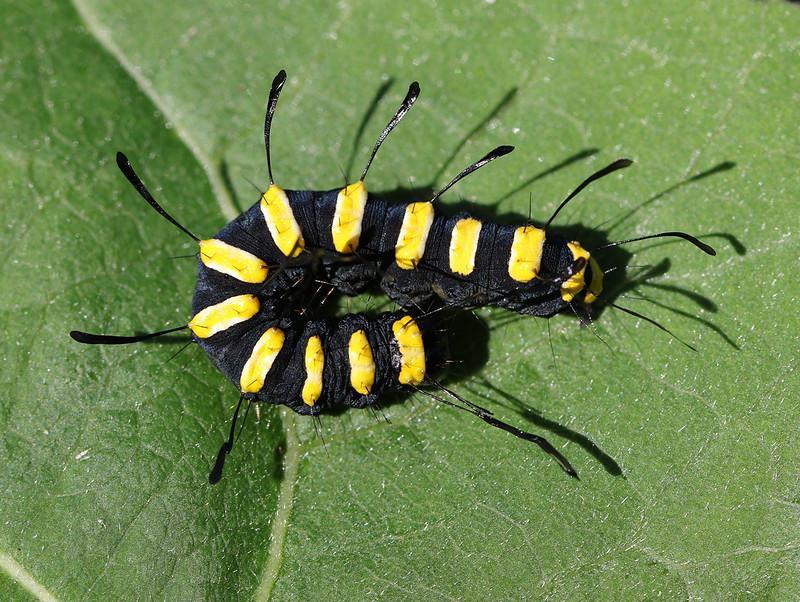
Fun Fact: It has distinctive hair-like tufts on its body that give it a fuzzy, almost cute look.
Quick Facts
| Scientific Name | Acronicta alni |
| Other Names | Alder Moth, Alder Dagger Moth Caterpillar, Speckled Footman |
| Length | Up to 5 cm (2 inches) |
| Width | Up to 1 cm (0.4 inches) |
| Host Plants | Alder, Birch, Hazel, and other deciduous trees |
| Distribution | Found in Europe, Asia, and North America |
| Dangerous or Not? | Generally not dangerous to humans. |
| Pest Status & Damage | The caterpillars can defoliate trees |
Description & Identification Guide
Although Alder moth Caterpillars are easy to identify, they are not seen very often, maybe because they tend to live well above eye level, feeding on the upper side of leaves. However, if you spot one, you can almost immediately recognize it.
These caterpillars have club-shaped large setae, glossy black bodies, and bright yellow stripes. Still, you might have difficulty spotting young caterpillars as they are tiny and resemble bird droppings.
14. White Flannel Moth Caterpillar
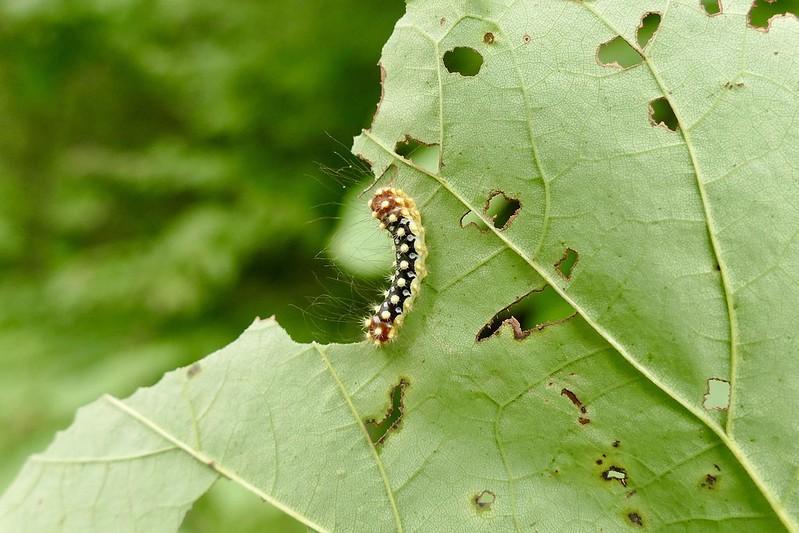
Fun Fact: The White Flannel Caterpillar’s hairs conceal venomous spines that cause intense pain if touched.
Quick Facts
| Scientific Name | Norape ovina |
| Other Names | White Flannel Moth Caterpillar, Puss Caterpillar, Southern Flannel Moth |
| Length | Up to 4 cm (1.5 inches) |
| Width | Up to 2 cm (0.8 inches) |
| Host Plants | Various trees and shrubs, including citrus and oak |
| Distribution | Found in the southern United States, Central America, and South America |
| Dangerous or Not? | Considered dangerous due to venomous spines |
| Pest Status & Damage | It can harm trees and cause skin irritation |
Description & Identification Guide
White Flannel Moth Caterpillars are about one or two inches long when fully grown and have a few long, plumose setae. They also have seven pairs of prolegs, the fleshy, peglike legs along the abdominal segments. All other butterfly and moth caterpillars have five or fewer pairs. The yellow dots can quickly identify these caterpillars on their black ‘backs’ with centers of short, white, stinging, and venomous hair.
RELATED: Furry Caterpillar Types with An Identification Guide, Fun Facts, And Pictures
15. Fall Webworm
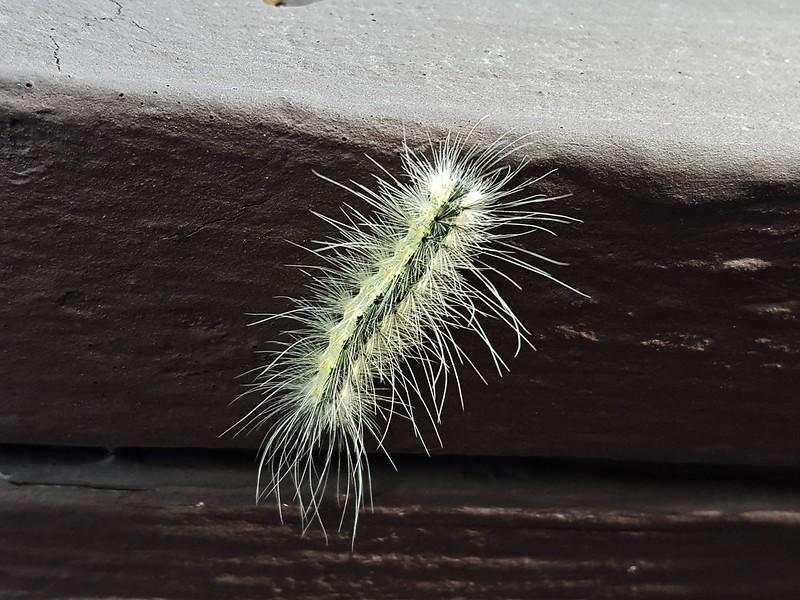
Fun Fact: Fall webworms are not harmful to humans; some people eat them as a source of protein.
Quick Facts
| Scientific Name | Hyphantria cunea |
| Other Names | The eastern fall webworm, white hairy caterpillar, fall webworm moth |
| Length | 2.5-4 cm (1-1.5 inches) |
| Width | 4-5 cm (1.5-2 inches) |
| Host Plants | Over 600 species of trees and shrubs, including walnut, pecan, apple, and oak. |
| Distribution | Found throughout North America, Europe, Asia, and parts of Africa. |
| Dangerous or Not? | Not dangerous but can cause the defoliation of host plants. |
| Pest Status & Damage | It feeds on the leaves of trees and can cause defoliation. |
Description & Identification Guide
Even though we have included fall webworms in the yellow and black caterpillars list, these moth caterpillars are highly variable in color. Some are pale yellow, while others are dark grey. However, they all have yellow spots and long and short bristles. These caterpillars can build large silk tents that sometimes spread over several branches. So, you will have no problem if you ever try to find these on their preferred host plants.
16. Smeared Dagger Moth Caterpillar
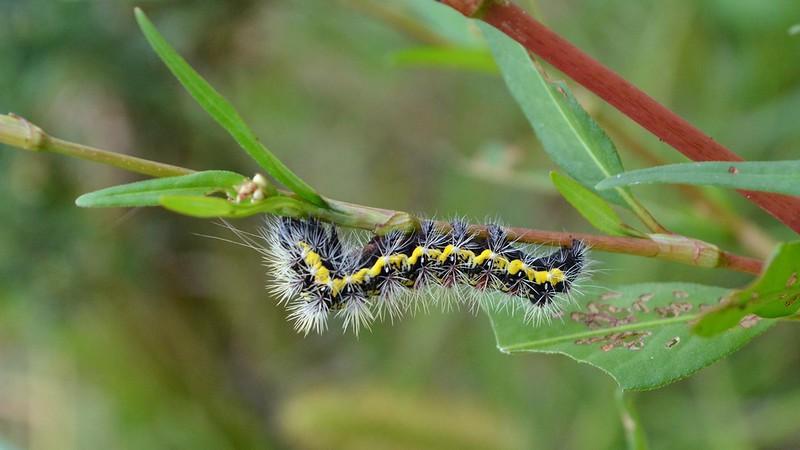
Fun Fact: The “smear” on the caterpillar’s back is a defense mechanism with chemicals that deter predators.
Quick Facts
| Scientific Name | Acronicta oblinita |
| Other Names | Smeared dagger, Acronicta dagger moth, Spotted green fruit worm |
| Length | 4-5 cm (1.5-2 inches) |
| Width | 1-2 cm (0.5-0.75 inches) |
| Host Plants | Various deciduous trees and shrubs, including oak, maple, and birch. |
| Distribution | Found throughout much of North America. |
| Dangerous or Not? | It may cause skin irritation if handled, but not dangerous to humans or pets. |
| Pest Status & Damage | Considered a pest |
Description & Identification Guide
Smeared Dagger Moth Caterpillar is also variable in color. However, it is primarily black. An average-sized caterpillar is about 4 inches long and has white breathing pores with a large, bright yellow, inverted V-shaped blotch between the spiracles. You can quickly identify Smeared Dagger Moth Caterpillar with its bristly black body, white markings on the back, and the characteristics of red spots and bright yellow longitudinal bands.
17. American Dagger Caterpillar
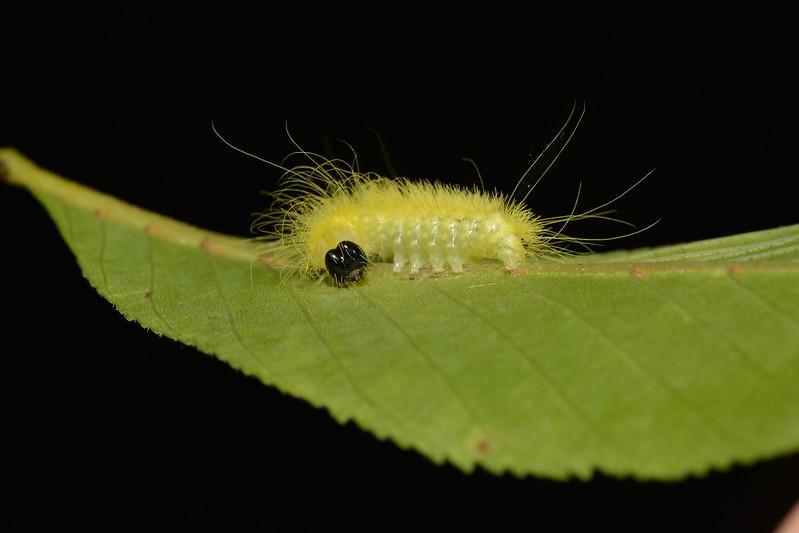
Fun Fact: When threatened, it arches its back and displays bright red spots, making it look more intimidating.
Quick Facts
| Scientific Name | Acronicta americana |
| Other Names | American dagger moth caterpillar |
| Length | 4-5 cm (1.5-2 inches) |
| Width | 1-2 cm (0.5-0.75 inches) |
| Host Plants | Various deciduous trees and shrubs, including oak, maple, and birch. |
| Distribution | Found throughout much of North America. |
| Dangerous or Not? | It may cause skin irritation if handled, but not dangerous to humans or pets. |
| Pest Status & Damage | Considered a pest |
Description & Identification Guide
American Dagger Caterpillar has a remarkable size and appearance, and its bristly stinging hair has a reputation for teaching children not to touch everything they see. Nevertheless, to identify these caterpillars, look for the black setae on the first and third abdominal segments. Also, the caterpillar’s body is yellow or pale and is covered densely with fluffy hair.
18. Redhumped Caterpillar
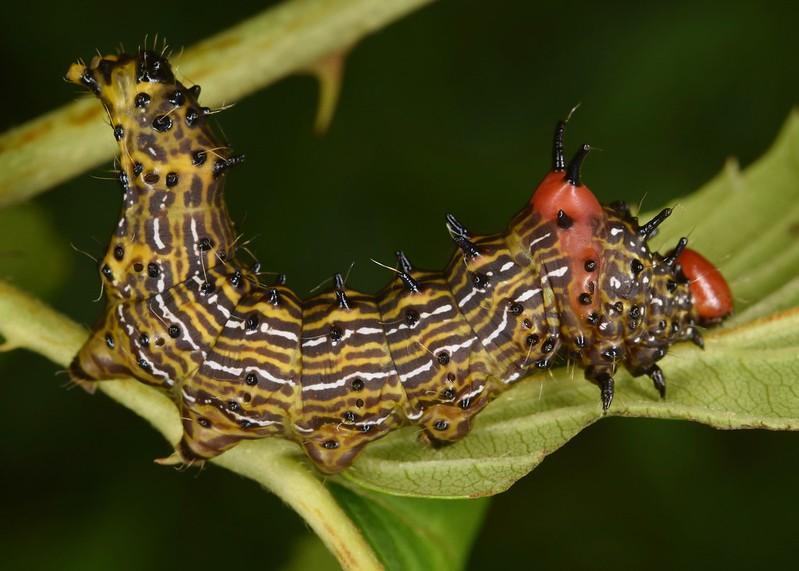
Fun Fact: the hump on caterpillars contains a scent gland that can release a foul odor to deter predators.
Quick Facts
| Scientific Name | Schizura concinna |
| Other Names | Redhumped oak worm |
| Length | 5-6 cm <br> 2-2.5 inches |
| Width | 1-2 cm <br> 0.5-0.75 inches |
| Host Plants | Various deciduous trees, including oak, maple, and hickory. |
| Distribution | Found throughout much of North America. |
| Dangerous or Not? | Not dangerous to humans or pets but can cause skin irritation if handled. |
| Pest Status & Damage | Can defoliate trees and shrubs. |
Description & Identification Guide
These caterpillars have yellowish-orange bodies with lengthwise black and white stripes. However, their most noticeable feature is that red hump. Aside from that, these colorful caterpillars have darker shades of grey and are thus well camouflaged in woody places. Also, they usually appear in midsummer and eat the whole leaf, leaving only the midrib.
19. Grapeleaf Skeletonizer Caterpillar

Fun Fact: The caterpillar can sequester toxins from its host plants, making it unpalatable to predators.
Quick Facts
| Scientific Name | Harrisina americana |
| Other Names | Grape leaf skeletonizer |
| Length | 1.5-2 cm <br> 0.5-0.75 inches |
| Width | 0.3-0.5 cm <br> 0.1-0.2 inches |
| Host Plants | Grape and Virginia creeper plants. |
| Distribution | Found throughout much of North America. |
| Dangerous or Not? | If handled, it can cause skin irritation, and its hair can be harmful if ingested. |
| Pest Status & Damage | Defoliate grape vines and other plants. |
Description & Identification Guide
Grape leaf Skeletonizer Caterpillar has a primarily yellow and black body with white hair on the underside of the body. Small, black, and bristly hairs also emerge in clumps from each black band on its backside. Once hatched, the caterpillars feed for about 40 days on the host plants and then pupate for two weeks. Another fun fact about these caterpillars is that they move in a line from one plant to another when feeding.
RELATED: Types Of Green Caterpillars With Fun Facts, Stunning Pictures And Loads More!!!
20. Mullein Moth Caterpillar
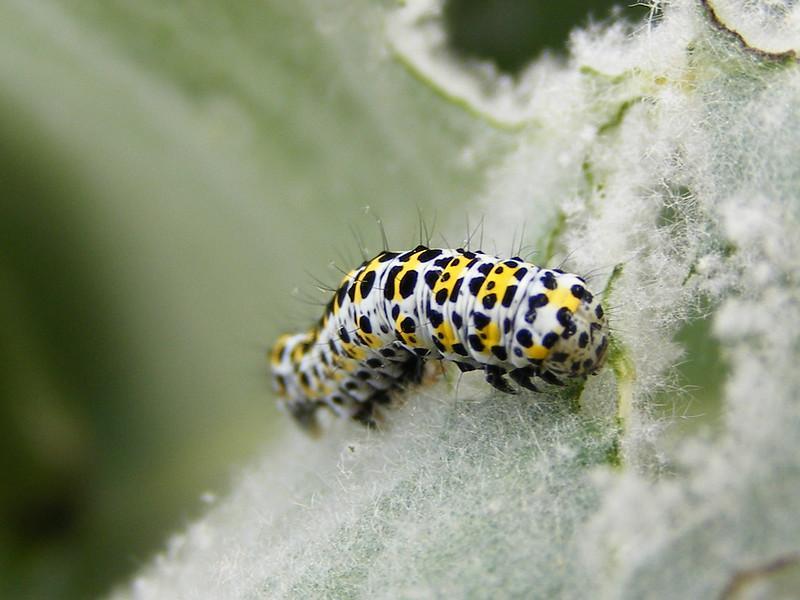
Fun Fact: The caterpillar curls up into a tight ball when disturbed, making it difficult for predators to attack.
Quick Facts
| Scientific Name | Cucullia verbasci |
| Other Names | Verbascum moth, great mullein moth, woolly bear caterpillar |
| Length | 4-5 cm (1.5-2 inches) |
| Width | 1 cm (0.4 inches) |
| Host Plants | Mullein (Verbascum spp.) and figwort (Scrophularia spp.) |
| Distribution | Found throughout Europe and Asia, as well as in parts of North America |
| Dangerous or Not? | Not dangerous to humans or pets. |
| Pest Status & Damage | Pest in gardens and agricultural areas |
Description & Identification Guide
These brightly colored yellow and black caterpillars are easy to spot as they crawl across the leaves. And, since they are not harmful to the touch, they can be picked off by hand. The caterpillar’s body is whitish, with regular yellow patches and black dots. Once hatches, they eat for about 40 days and reach a size of about 5 cm. If you want to find this caterpillar, the best time to look for them is from July to August on their host plants.
21. Yellownecked caterpillar
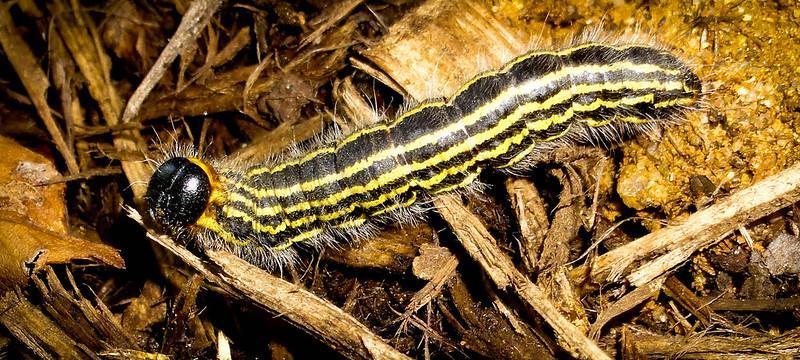
Fun Fact: They form large clusters on host plants, often in large numbers, before moving to new feeding areas.
Quick Facts
| Scientific Name | Datana ministra |
| Other Names | Yellow-necked apple worm moth, walnut caterpillar, Datana caterpillar |
| Length | 4-5 cm (1.5-2 inches) |
| Width | 1 cm (0.4 inches) |
| Host Plants | Various deciduous trees, including apple, cherry, oak, and walnut |
| Distribution | Found throughout North America |
| Dangerous or Not? | Not dangerous to humans or pets. |
| Pest Status & Damage | Considered a pest in orchards and forests. |
Description & Identification Guide
Yellow-necked caterpillar is green when it is young. However, as it ages, the body becomes orange and entirely yellow. The caterpillar also develops black and yellow stripes on the body as it matures, and its forelegs become red. You can also see a tuft of white, spiny hair from each body segment with a sensory function. When threatened, the caterpillar raises its front part and clings to the leaves or stems wit its abdominal segments.
22. Black Swallowtail Caterpillar
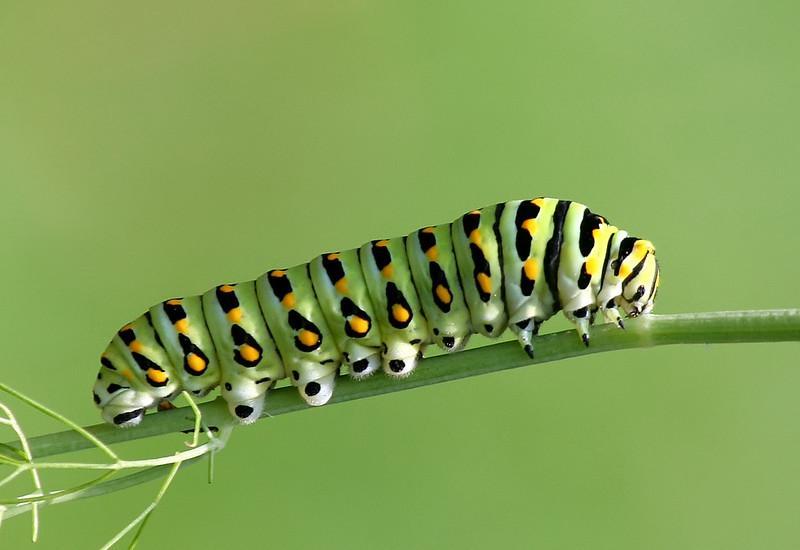
Fun Fact: To avoid predators, these caterpillars mimic bird droppings in their early stages.
Quick Facts
| Scientific Name | Papilio polyxenes |
| Other Names | American swallowtail, parsnip swallowtail, parsley worm |
| Length | 4-5 cm (1.5-2 inches) |
| Width | 1 cm (0.4 inches) |
| Host Plants | Various plants in the Apiaceae family, including parsley, dill, fennel, and carrot |
| Distribution | Found throughout North America |
| Dangerous or Not? | Not dangerous to humans or pets. |
| Pest Status & Damage | Considered a pest in gardens and agricultural areas. |
Description & Identification Guide
Although these caterpillars look primarily green, they have black and yellow body markings, which is why they are included in this list. These caterpillars also have another color which some people miss. They have a “forked gland” called the osmeterium, which looks like a snake’s tongue and is present on the back of their heads. It is orange and everts and releases a foul smell when threatened to repel potential predators.
23. Brown-hooded Owlet
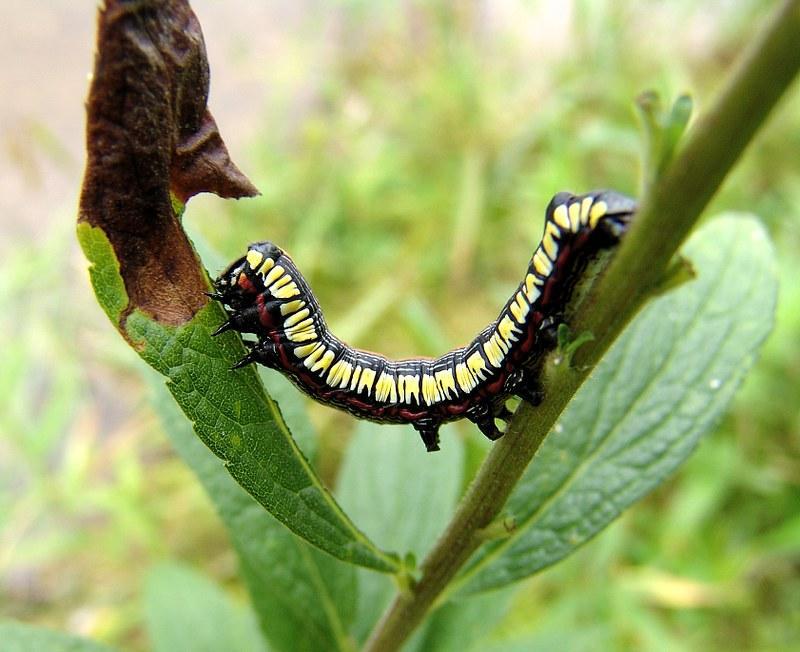
Fun Fact: It has a distinctive humpbacked appearance, which makes it look like a miniature camel.
Quick Facts
| Scientific Name | Cucullia convexipennis |
| Other Names | Calico Paint caterpillar |
| Length | 3-4 cm (1.2-1.6 inches) |
| Width | 1-1.5 cm (0.4-0.6 inches) |
| Host Plants | Various plants in the Asteraceae family, including sunflowers and asters |
| Distribution | Found throughout North America |
| Dangerous or Not? | Not dangerous to humans or pets. |
| Pest Status & Damage | Considered a pest in gardens and agricultural areas. |
Description & Identification Guide
As you can tell by its name, The Calico Paint caterpillar, this moth larva has many features that can be used to identify it. For example, it has short yellow and white lines, with a horizontal red line along the bottom by the legs. Aside from that, a deep orange line is centered between yellow pinstripe lines that run down the ‘back.’ And lastly, it has a glossy black head with yellow lines and marks. So, identifying it is easy.
24. Yellow and Black Cinnabar Caterpillar
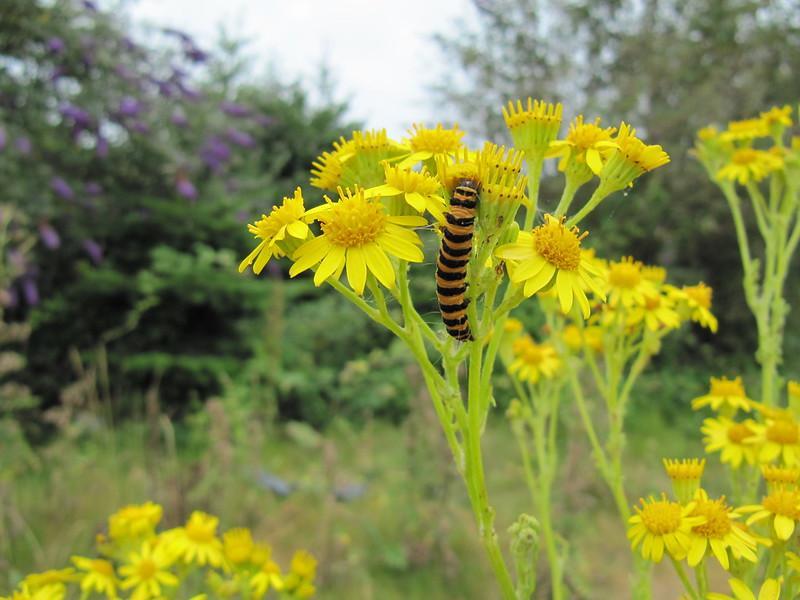
Fun Fact: Yellow and Black Cinnabar Caterpillars are used as a biological control for ragworts in New Zealand.
Quick Facts
| Scientific Name | Tyria jacobaeae |
| Other Names | Cinnabar moth caterpillar |
| Length | 3-4 cm (1.2-1.6 inches) |
| Width | 0.5-1 cm (0.2-0.4 inches) |
| Host Plants | Poisonous plants in the genus Senecio, including ragwort and groundsel |
| Distribution | Found throughout Europe, Asia, and parts of North America |
| Dangerous or Not? | Not dangerous to humans or pets. |
| Pest Status & Damage | Considered a pest in some areas |
Description & Identification Guide
The caterpillar’s bright colors warn predators not to eat them. And they are particularly fond of munching on ragwort plants. Talking about their appearance, they are jet black with yellow/orange stripes. You might also notice that thin hair-like black or white spines grow sparsely on its body. Another interesting fact about these caterpillars is that if they do not get enough food from host plants, they turn cannibalistic and eat other larvae.
25. Common Sheep Moth Caterpillar
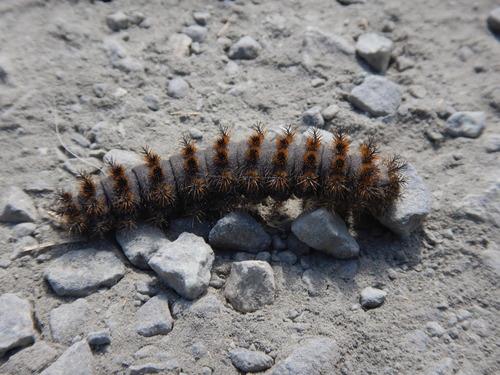
Fun Fact: It is dangerous to livestock and can cause “blister beetle poisoning” if ingested.
Quick Facts
| Scientific Name | Hemileuca eglanterina |
| Other Names | Buck moth caterpillar, sheep moth |
| Length | 4-5 cm (1.5-2 inches) |
| Width | 1 cm (0.4 inches) |
| Host Plants | Various plants in the rose family, including blackberry and raspberry |
| Distribution | Found throughout North America |
| Dangerous or Not? | It can cause skin irritation and allergic reactions in humans and pets. |
| Pest Status & Damage | Caterpillars can defoliate and damage host plants |
Description & Identification Guide
These caterpillars are black with a yellow-brown head, and their body is covered with off-white spines that become bright yellow or orange when they mature. These spines have many white and black branches. They are tipped with stiff quills that point sideways and upwards, forming a bristling defense system – a clear sign to stay away.
26. Black and Yellow Zebra Caterpillar

Fun Fact: It gets its name from the bold black and yellow stripes that run down its body, resembling a zebra.
Quick Facts
| Scientific Name | Melanchra picta |
| Other Names | Zebra caterpillar, yellow and black cutworm |
| Length | 4-5 cm (1.5-2 inches) |
| Width | 1 cm (0.4 inches) |
| Host Plants | Various plants in the Asteraceae family, including sunflowers and daisies |
| Distribution | Found throughout North America |
| Dangerous or Not? | Not dangerous to humans or pets. |
| Pest Status & Damage | Considered a pest in some areas. |
Description & Identification Guide
If you see a yellow and black caterpillar resembling a zebra, it is a Black and Yellow Zebra Caterpillar. Easy! However, if that is not enough, let us give you a good identification guide. The Zebra Caterpillar often feeds on cabbages, beets, and other cultivated plants. It has black stripes around the segments, and its underside is somewhat reddish. Aside from that, the caterpillar has an overall pale yellow body with black, yellow, and white stripes.
27. Giant Sphinx Caterpillar
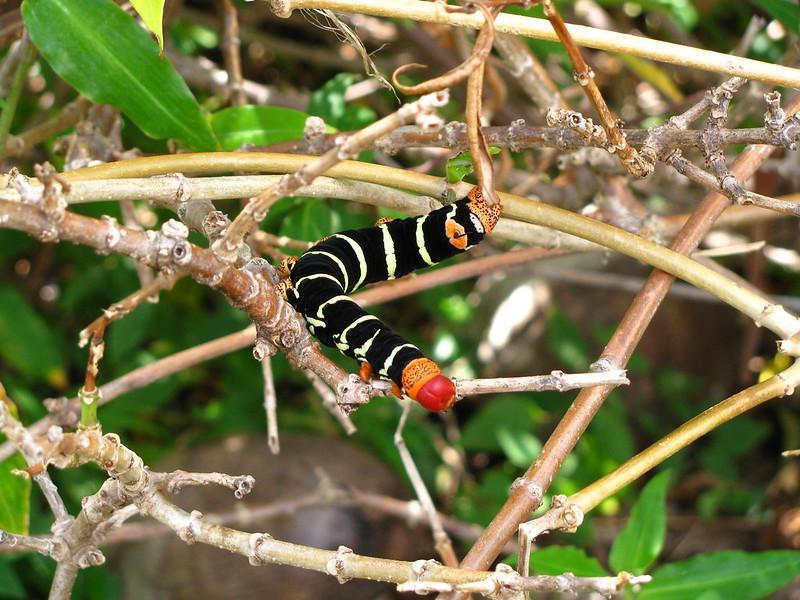
Fun Fact: When threatened, it will rear its head and emit a loud hissing sound, which startles the attacker.
Quick Facts
| Scientific Name | Pseudosphinx tetrio |
| Other Names | Tetrio Sphinx, Greater Sphinx |
| Length | 10-12 cm (4-5 inches) |
| Width | 2-3 cm (0.8-1.2 inches) |
| Host Plants | Various plants in the nightshade family, including tomato and tobacco |
| Distribution | Found throughout Central and South America, as well as in parts of the southern United States |
| Dangerous or Not? | Not dangerous to humans or pets. |
| Pest Status & Damage | The caterpillars can defoliate and damage host plants |
Description & Identification Guide
The caterpillar has a size that matches its name, and it can grow up to 15 cm in length in some cases. Aside from that, the caterpillar has black horns on its orange tail, a red-orange head, and red prolegs on an overall black body with regular yellow stripes. Furthermore, these caterpillars often appear in gardens and can have large leaves in just a few days. And in the last instars, caterpillars become green with a dark purple center back line.
28. Catalpa Sphinx
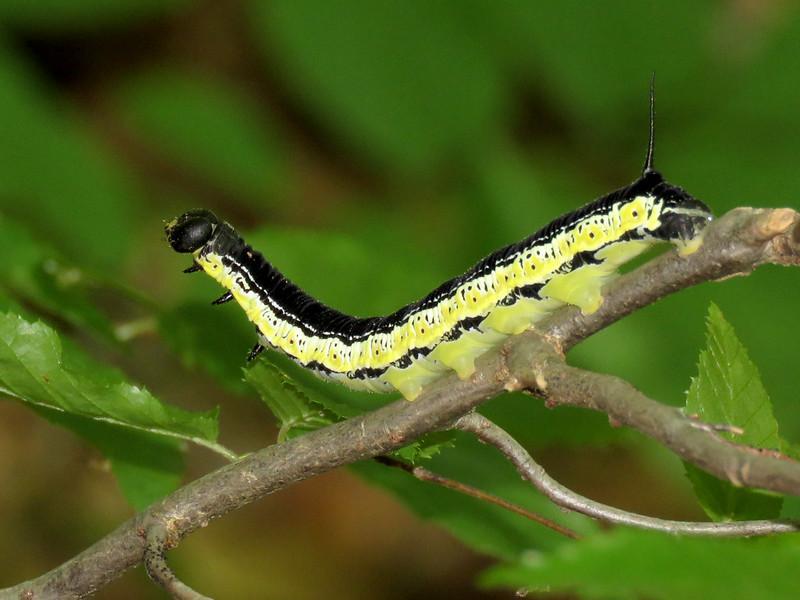
Fun Fact: These caterpillars are juicy and highly prized as bait for fishing, especially for catfish.
Quick Facts
| Scientific Name | Ceratomia catalpae |
| Other Names | Catalpa worm, Catawba worm |
| Length | 5-7 cm (2-2.75 inches) |
| Width | 1-2 cm (0.4-0.8 inches) |
| Host Plants | Catalpa trees |
| Distribution | Found throughout the eastern United States |
| Dangerous or Not? | Not dangerous to humans or pets. |
| Pest Status & Damage | Caterpillars can defoliate catalpa trees. |
Description & Identification Guide
Catalpa Sphinx Caterpillars are primarily white with black spots. However, as they age, they become variable in color and can range from chiefly yellow to almost entirely black. Furthermore, they have shiny heads, and their lengthwise yellow or green and black stripes become more apparent in giant caterpillars. If you want to look for them, you can find them on native catalpa trees or cigar trees in many US states.
29. Queen Caterpillar
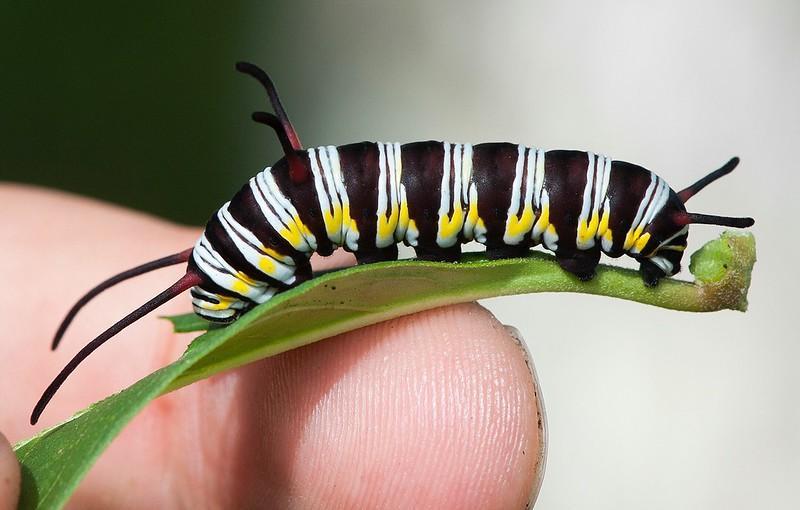
Fun Fact: it feeds on milkweed plants, which makes it distasteful and toxic to many predators.
Quick Facts
| Scientific Name | Danaus gilippus |
| Other Names | Queen butterfly caterpillar |
| Length | 4-5 cm (1.5-2 inches) |
| Width | 0.5-1 cm (0.2-0.4 inches) |
| Host Plants | Various milkweed species |
| Distribution | Found throughout North and South America |
| Dangerous or Not? | Not dangerous to humans or pets. |
| Pest Status & Damage | Not considered a pest |
Description & Identification Guide
The queen caterpillar is one of the most beautiful caterpillars on this list, with black tentacles, white/black stripes, and yellow dots on a somewhat green body. However, the stripes may change in color depending on the life stage. It is nearly identical to the caterpillar of Danaus chrysippus. The caterpillar reaches its full size in 2-3 weeks and then pupates.
30. Six-Spot Burnet Caterpillar
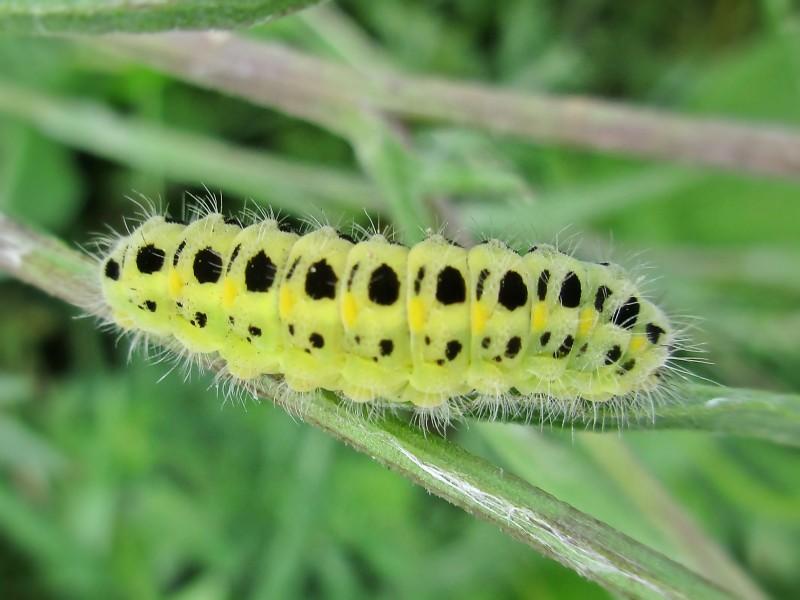
Fun Fact: The Six-Spot Burnet Caterpillar has striking black and yellow stripes reminiscent of a wasp.
Quick Facts
| Scientific Name | Zygaena filipendulae |
| Other Names | Six-Spot Burnet Moth Caterpillar |
| Length | 2-3 cm (0.8-1.2 inches) |
| Width | 0.5-1 cm (0.2-0.4 inches) |
| Host Plants | Various plants in the pea family, including clover and bird’s-foot trefoil |
| Distribution | Found throughout Europe and Asia |
| Dangerous or Not? | Not dangerous to humans or pets. |
| Pest Status & Damage | Not considered a pest |
Description & Identification Guide
Native to the UK, it is a fat yellow caterpillar with black markings in horizontal stripes. It is about two to three cm in length, and if you look closely, you might see tufts of white hair arising from its body. The body is divided into several small segments with two small, square-shaped black dots on each part. The term “six-spot” comes from the look of the butterfly’s glossy black wings, which the caterpillar will mature into later.
Final Thoughts
There you have it! A comprehensive identification guide for yellow and black caterpillars. There may be many more species of black and yellow caterpillars; however, the ones mentioned above are probably the ones you will come across in the wild and other places. Lastly, no matter how cute you find a yellow and black caterpillar, please do not touch it, no matter how tempted you are, unless you are sure it is safe to handle.
Hope you find this black and yellow caterpillars identification guide helpful. Also, check out our other articles:
How To Get Rid Of Sweat Bees Quickly & Easily? Simple Ways That Work
Soil Mites In Houseplants? Here Is How To Get Rid Of Them For Good!
Do Grasshoppers Bite? Are They Dangerous? And Many More Fun Facts!







